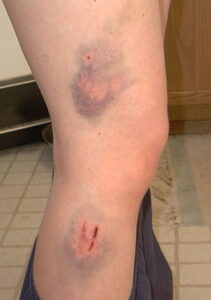Barks Blog
Portland Blog Competition: Lessons from Bogie
By Shannon Finch

I want to warn you at the outset, Bogie’s story doesn’t have a happy ending. Everything that could go wrong did go wrong for this dog, with mistakes compounded by more mistakes. It’s been over 15 years since I worked with Bogie, but I clearly remember every detail about him. He was a 7-month-old German shepherd with severe fear issues that started when he was attacked in the car by his family’s other dog. The owners came back from dinner to a horrific sight of blood all over the car and a severely injured, traumatized puppy.
I had been a professional trainer for 10 years successfully working with many fearful and aggressive dogs, so I felt comfortable working with Bogie. His progress was slow, a little up and down, but the owners were encouraged. One of the things we did at our sessions was allow him to run a little in my woods before we started working. It gave him a chance to sniff and work off a little energy after a long car ride. On one particular day, my client said that Bogie had had a bad weekend, and asked if I was sure I wanted to let him loose. I told her I thought it would be fine to let him out and we’d talk more about it while he ran around. Instead of playfully running around, however, Bogie ran straight at me, fast, low and silent. He bit me on the knee and calf, and then on the back of my thigh as I turned away from him. He would have continued to bite me except that I shoved the paperwork I had in my hand into his mouth. This distracted him enough for me to scramble onto the hood of my car and for my client to grab him.
We had no session that day. Bogie went home, and I went to the doctor to get my wounds fixed up. Later, my client told me what had happened that weekend. They had had guests, and Bogie had been whining and crying in his crate, so her husband used a shock collar to keep him quiet. Things suddenly became very clear. I now understood why Bogie’s progress was so sporadic. My client used positive reinforcement, but her husband was using fear, pain and punishment, and had been all along. It had escalated to Bogie being shocked in a crate, with no way for him to escape. I felt physically sick. I hadn’t thought to question my client about what her husband had been doing, though I knew he leaned towards punitive training. We had had a discussion about it in the beginning, but I obviously had not convinced him about the dangers of using punishment.
I, too, set Bogie up to fail that day. I was worn out from an intense schedule, so I wasn’t at my best. I didn’t listen to my client when she said Bogie had had a bad weekend. If I had rescheduled the appointment, or had listened to her and changed the game plan, the bites wouldn’t have happened.
Prior to this, I had never been bitten, and I took it seriously. I immediately changed how I worked with aggressive dogs and I still follow this protocol today. I limit the number of aggression consults I do per week, and schedule them for when I am fresh and alert. I diligently check in with the client before each session to make sure that something hasn’t changed, and ask them to keep me updated between appointments. I remind my clients, and myself, to train the dog you have in the moment.
You could say that Bogie “liked” me in his way. But that day he was under the influence of severe stress, not in his right mind, so to speak, and not responsible for what happened. That was on the humans. I now have a policy that I will not work with an aggressive dog if someone in the family is not on board with positive reinforcement training. Many times people just don’t know what to do, and punishment is seductive and comes easy. To avoid that, we create a management plan to smooth the way during the re-training. If I’ve educated a client about the pitfalls of punishment, and he still decides to use it, I’m out. It’s a waste of everyone’s time and the client’s money. Moreover, it’s unfair, and in my opinion, cruel to the dog. Can you imagine going through life always uncertain, never knowing what to expect from your people? I abhor the idea of training by punishment, but if I can’t convince someone otherwise, than I think it’s better for the dog to know what to expect.
A few months later Bogie bit a family member, not as severely as me, but still. His owners euthanized him. He had just turned 1 year old. My heart still hurts when I think about what Bogie endured. Fear was the overriding emotion in his short life: fear of the other dog in the family, other dogs in general, other people, and the world at large. Worst of all was fearing the person who was supposed to be his guardian and protector.
Bogie looks over my shoulder with every aggression case I do. Because of him, I think carefully about how my actions, intentional or not, have consequences for others. I sometimes wonder, if he hadn’t bitten me, maybe he wouldn’t have learned about using his teeth as a coping strategy. I have to live with my part in that. But the lessons I learned from him have helped me help so many other troubled dogs. That was Bogie’s legacy, and it was, and is, such a gift.
*This post is the joint winner in our Portland 2019 Writers’ Competition. All winning and runner up entries will be published in the March 2019 issue of BARKS from the Guild. To learn more about canine and feline aggression, join us at the Pet Professional Guild Canine Aggression and Bite Prevention Educational Seminar (with bonus feline specialty track) in Portland, Oregon April 26-28, 2019.*
About the Author
Shannon Finch M.Ed operates AnimalKind Training in Stanwood, Washington offering positive training and behavior modification for all species through classes, clinics, and private sessions. She is a graduate of the Karen Pryor Academy for Animal Training and Behavior and is a KPA certified training partner. She is also a certified Tellington TTouch practitioner for both companion animals and horses.


